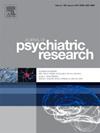自我报告的反社会人格障碍症状水平与迫在眉睫的威胁的神经反应性之间的负相关
IF 3.7
2区 医学
Q1 PSYCHIATRY
引用次数: 0
摘要
反社会人格障碍(ASPD)个体表现出威胁/挫折为基础的反应性攻击和目标导向攻击的高风险。这种高风险可能与对环境威胁的非典型神经反应有关。本研究的目的是调查不同程度的自我报告的反社会人格障碍个体对威胁性面部刺激的神经反应。方法招募54名男性参与者,包括27名被关押在司法警察医院的暴力罪犯和27名来自社区的个人。所有的参与者都接受了依赖于血氧水平的功能磁共振成像(fMRI),同时进行了一项实验,该实验包括反复呈现愤怒和中性的面部刺激,这些刺激要么逼近,要么远离。ASPD水平采用自报告型人格障碍问卷中的ASPD子量表进行测量。结果反社会人格障碍症状与左侧颞上回(STG)、左侧颞下回和右侧腹侧被盖区(VTA)的威胁反应(若隐若现的愤怒面孔与若隐若现的中性面孔)呈显著负相关。结论本研究提供证据支持自我报告的反社会人格障碍水平与威胁反应能力下降之间的联系。心理理论(ToM)和面部识别的大脑区域的非典型激活,特别是在威胁感知的背景下,与自我报告的反社会障碍症状水平的增加有关。本文章由计算机程序翻译,如有差异,请以英文原文为准。
Negative correlation between level of self-reported antisocial personality disorder symptoms and neural responsiveness to looming threats
Objective
Individuals with antisocial personality disorder (ASPD) exhibit an elevated risk for both threat/frustration-based reactive aggression and goal-directed aggression. This heightened risk may be associated with atypical neural responses to environmental threats. The objective of this study was to investigate neural responsiveness to threatening facial stimuli among individuals with varying levels of self-reported ASPD.
Methods
Fifty-four male participants were recruited, comprising 27 violent offenders incarcerated in a judicial police hospital and 27 individuals from the community. All participants underwent blood-oxygenation-level-dependent fMRI while engaging in an experiment that involved repeated presentations of angry and neutral facial stimuli, which either loomed towards or receded from them. The level of ASPD was measured using the ASPD subscale from the self-report Personality Disorder Questionnaire.
Results
A significant negative correlation was observed between ASPD symptoms and threat responsiveness (looming angry faces versus looming neutral faces) within the left superior temporal gyrus (STG), left inferior temporal gyrus and right ventral tegmental area (VTA).
Conclusion
This study provides evidence supporting the association between self-reported levels of ASPD and diminished threat responsiveness. The atypical activation of brain regions underlying the theory of mind (ToM) and facial recognition, particularly in the context of threat perception, is correlated with an increased level of self-reported ASPD symptoms.
求助全文
通过发布文献求助,成功后即可免费获取论文全文。
去求助
来源期刊

Journal of psychiatric research
医学-精神病学
CiteScore
7.30
自引率
2.10%
发文量
622
审稿时长
130 days
期刊介绍:
Founded in 1961 to report on the latest work in psychiatry and cognate disciplines, the Journal of Psychiatric Research is dedicated to innovative and timely studies of four important areas of research:
(1) clinical studies of all disciplines relating to psychiatric illness, as well as normal human behaviour, including biochemical, physiological, genetic, environmental, social, psychological and epidemiological factors;
(2) basic studies pertaining to psychiatry in such fields as neuropsychopharmacology, neuroendocrinology, electrophysiology, genetics, experimental psychology and epidemiology;
(3) the growing application of clinical laboratory techniques in psychiatry, including imagery and spectroscopy of the brain, molecular biology and computer sciences;
 求助内容:
求助内容: 应助结果提醒方式:
应助结果提醒方式:


